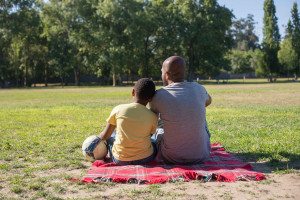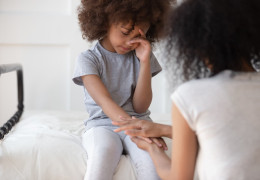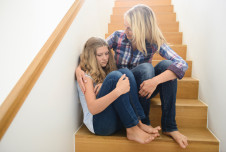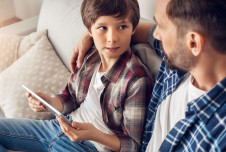“Mom, I’m feeling nervous,” my 12-year-old daughter shared one night as I tucked her into bed.

“Are you just having nervous feelings or are you thinking about something?” I asked.
“Ukraine,” she replied.
I asked if she wanted to talk about it.
She didn’t.
“I just want you to tell me a story—a happy story—to help me fall asleep.”
In that moment, I found myself going through the eternal parenting struggle—the struggle of wanting to do or say the right thing and not knowing exactly what that was. I wanted to know if she had talked about Ukraine at school or if she had heard something in the news. I wanted to ask what it was that made her feel nervous and what I could do to help her feel safe. Before bombarding her with my growing list of questions, I paused and realized that my daughter had already let me know exactly what she needed. She wanted me to tell her a story—a happy story—to help her fall asleep. I understood that feeling. Most days, I would have liked that, too. So, that’s what I did. I shared a happy story and left the conversation about Ukraine for another day.
Like my daughter, I had also been thinking about Ukraine. Earlier that week, I had connected with Evghenia, a friend and colleague living in the United States with deep roots in Ukraine. Outside of work, Evghenia was spending every waking moment monitoring the safety of Ukrainian family members and friends while collecting donations and supplies to support refugee efforts. She had prepared her home to receive friends seeking refuge and was teaching a Slavic parenting class, which included both Ukrainian and Russian families who were seeking support through connection and community. Even from the United States, Evghenia and her family were living and breathing the reality of the war in Ukraine. For Evghenia and her daughter, the war in Ukraine was not a conversation that could wait for tomorrow.
For me, even as a parenting education specialist, the decision to come back to the conversation about Ukraine was not an easy one. When we choose not to talk about a topic, it is usually with good intentions and a desire to protect our children (and ourselves). We want our children to feel safe and loved. After all, the challenges of adulthood will be here soon enough. Why can’t we just “let kids be kids”?
The past few years have felt especially hard within the context of a global pandemic (a shared societal trauma), the resulting physical isolation, and the small and large disruptions to our everyday lives. Racial injustice has been raised in our collective consciousness, and natural disasters have devastated communities. Between moments of hope and joy, the children in our lives have experienced disappointment, sadness, grief, and loss. It’s no wonder we may feel hesitant to have conversations about challenging topics, such as the war in Ukraine, especially if it feels far from home.
Beyond the stresses of the past two years, there are many other reasons why we might not want to have conversations about sad or challenging topics, including:
- not feeling like we have the emotional bandwidth to think about one more challenge in the world.
- not wanting to add one more worry to the already-stressed lives of our children, especially with rates of anxiety and depression on the rise.
- having our own uncomfortable feelings about a topic, which can include sadness, grief, guilt, shame, or embarrassment.
- having concerns about compassion fatigue—the emotional and physical exhaustion that comes from “caring too much.”
Reminding ourselves that the conversations we avoid define another child’s life—like the children fleeing war in Ukraine—might be the boost we need to come back to that conversation we put off until tomorrow. Sometimes simply knowing that it is OK to have a challenging conversation may give us the confidence and courage to do so.
In fact, it’s more than OK to have these conversations. Every conversation we have with a child in our lives is an opportunity to strengthen our relationship, build their resilience and our own, and foster a more compassionate society. As adults, we have a lot to learn from children about empathy and compassion. From very young ages, children are sensitive to the feelings of others and show a desire to help when someone is in need. Conversations about Ukraine (and other tragedies), when handled sensitively, can help us learn more about how children’s compassion develops as we strengthen our own. Perhaps conversations such as these are what we need, too, for our own moral elevation and inspiration to take helpful action.
As you say yes to challenging conversations with the children in your life, including about the war in Ukraine, here are a few strategies to enhance your toolbox.
Build understanding by looking beyond the headlines
As a society, we are flooded with news that can feel overwhelming, stressful, and scary. Headlines often limit what we understand to a negative or sensationalistic perspective. Taking time to go beyond the headlines and learn more can build our knowledge and understanding of a topic so that we can feel comfortable talking with children in a way that is developmentally appropriate, as well as clearing up misconceptions.
- “You told me you were thinking about Ukraine. Can you tell me more about what you were thinking about? Did you talk about Ukraine at school or did you hear something on the news?”
- “I read more today about Ukraine and I’m ready to talk about it now. Would you like me to tell you what I learned now or later?”
Answer children’s questions honestly
Conversations with caring, trusted adults help children make sense of the world around them. Children are curious and have questions about what they see and hear. As they get older, children and youth will seek out information about topics they don’t understand. They will gain access to many different sources of information, not all of which are safe or trustworthy.
If children feel comfortable asking their questions to the trusted adults in their lives, they are more likely to return to those adults to keep having conversations as they get older. Even if you don’t have an answer to a question, talk together about strategies to look up information from sources you trust, and about what makes a source reliable.
- “What questions do you have? Did you hear anything that was confusing or scary?”
- “I don’t know the answer, but I know someone we can talk to who can help us learn more.”
- “Let’s see what we can find at the library about the history of Ukraine to help us understand.”
Manage emotions and foster resilience
Talking about sad or scary topics like the war in Ukraine may bring up many different emotions for you and for your child. Let them know that all feelings are OK. Help your child express their feelings in healthy ways, such as by talking about them; sharing feelings through stories, artwork, and play; taking a walk; or in other ways.
Share how you are managing your feelings, too, and help your child find strategies that work for them. Helping your child practice and develop skills to manage their stress and emotions through challenging conversations now can foster their resilience for challenges they may face in years ahead.
- “Talking about war can feel scary and sad. I have those feelings, too.”
- “Sometimes when I feel scared, I remind myself that I am safe here at home or at school. I ask a friend for a hug. I also think about what I can do to be a helper.”
- “What do you do when you feel scared or sad?”
Find ways to make a difference
Sometimes what feels most sad or scary are the things outside of our control, such as a war on the other side of the world or hardship or violence in our own communities. Share with your child examples of what people do to help one another and explore what you can do to make a difference in your own community (e.g., donating or volunteering) or in the world (e.g., supporting refugee relief efforts).
- “What do you think we could do to be helpers?”
- “What can you do to care for your friends who are feeling scared or sad?”
Focus on humanity
Not every conversation about a challenging topic needs to be about the stressful, harmful, or traumatic parts of a story. Talk with children about the people of Ukraine and the people of Russia. Learn together about the rich histories of each country, the languages spoken, cultural traditions celebrated, food, folktales, music, and more.
Your children will have friends, classmates, and community members now and in the future with diverse identities and from diverse backgrounds. Through these conversations, we can help teach children that the identities and cultural traditions each person carries are just as important to them as yours are to you. Having conversations that focus on humanity, including celebrating what we have in common as well as honoring our differences, allows children to see one another as part of the same global community.
- “I’m curious to learn more about what going to school is like in Ukraine. What are you curious about?”
- “What do you notice that’s the same between our family and the one in the story? What do you notice that is different?”
- “I checked out a book from the library with Slavic children’s stories. How about we read one together at bedtime?”
My daughter and I have now had many conversations about Ukraine. Some of our conversations have focused on the hardship and sadness of war, while others have focused on learning about Ukrainian and Russian people. These are the happy stories we can tell at bedtime. Together, they are all stories that help build understanding and compassion. Most recently, we watched the winning Eurovision video, “Stefania,” from Ukrainian artists Kalush Orchestra, a celebration of music and humanity of the Ukrainian people.
Taking the time to have each of these conversations—from the challenging to the happy and everything in between—has been an important reminder to find the humanity in every story, to be the helpers, and to be part of creating a society where every child is valued and every child belongs.








Comments